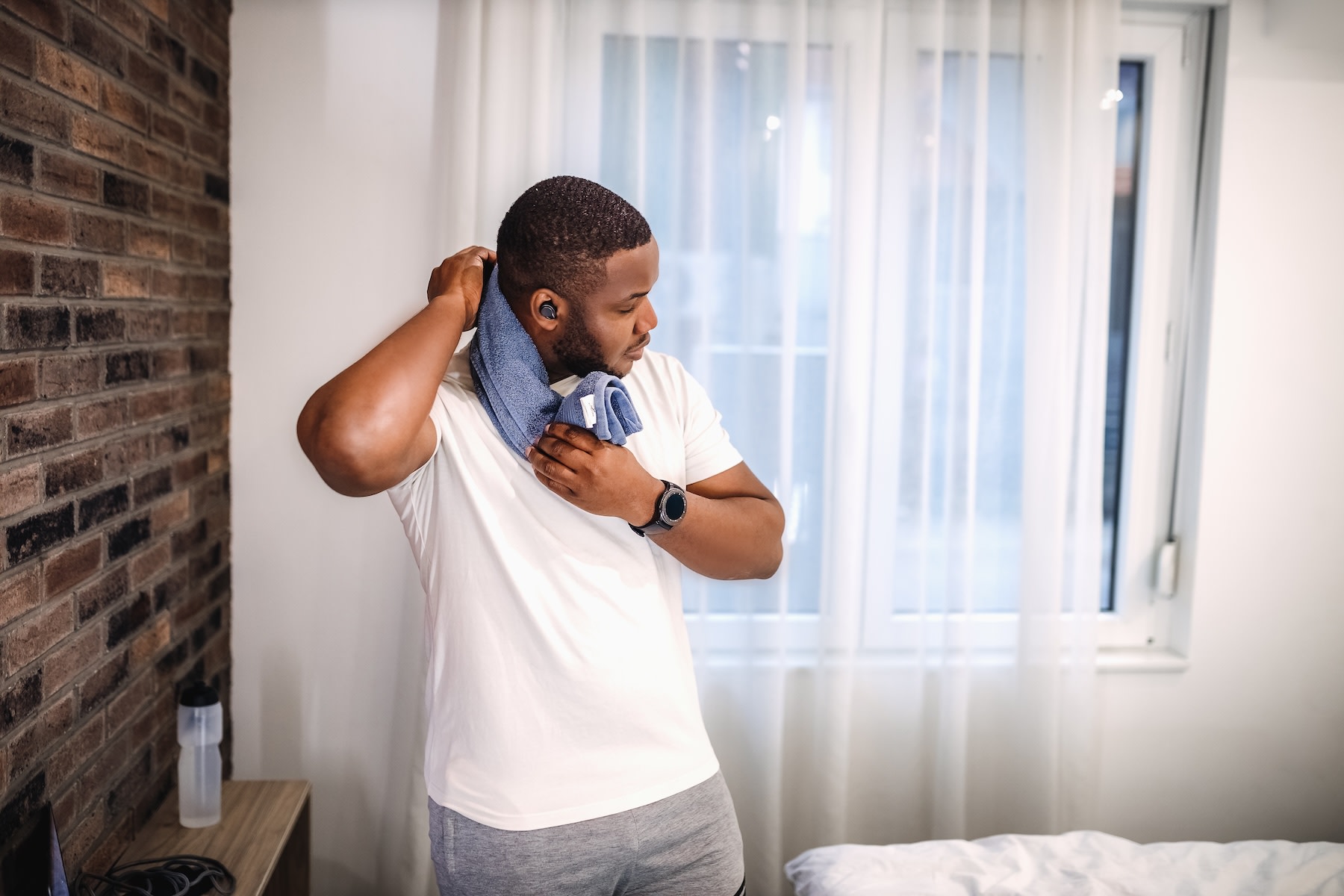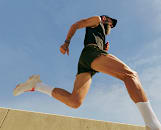
Jovan Doncic / E+ via Getty Images
When to Use Heat vs. Ice to Soothe Sore, Achy Muscles
Both can be helpful, but you’re going to want to time it right.
By Sarah Klein•
How Ice and Heat Can Alleviate Muscle Soreness
When to Use Ice or Heat for Sore Muscles
More Tips to Consider When Using Heat and Ice
The Takeaway
In the hours or days following a tough workout, you might find yourself feeling a little stiff, achy, and sore. You know you haven’t actually injured anything, but you’re still eager for relief. So should you use ice or heat for sore muscles? Here’s how to decide—and tips for using each method safely and effectively.
Discover more ways to reach your goals with Peloton
How Ice and Heat Can Alleviate Muscle Soreness
The good news is both ice and heat really can help ease muscle soreness, at least in the short term, says Sarav Shah, MD, a double board-certified orthopaedic surgeon and chief of sports medicine at New England Baptist Hospital. There isn’t convincing evidence yet that using either method helps with long-term healing or athletic performance, he adds, but if it’s short-term relief you’re after, you’ve got options.
Ice and heat both work a little differently when it comes to reducing your discomfort (more on that below). But you should also keep your personal habits and preferences in mind. “The best approach often depends on the stage of recovery, personal comfort, and individual response,” Dr. Shah says. “Some people find heat more soothing, while others get better relief from cold.”
In other words, if you prefer ice or heat over the other, you should feel free to use your soreness-reducer of choice. But if you’re open to either (or both!), here’s what to know about how they help.
How Ice Can Alleviate Soreness
Ice eases soreness by reducing inflammation, explains Sean Carpenter, a physical therapist at Memorial Hermann Health System. “When you apply cold, it causes vasoconstriction—narrowing of the blood vessels—which helps minimize swelling and slows down cellular activity to prevent further tissue damage by limiting blood flow to the area,” he explains. (That’s also the idea behind the benefits of a cold plunge!)
Best used within 24–48 hours after a workout (or injury), ice also “slows nerve conduction, providing a local numbing effect that can decrease pain,” Dr. Shah says. That’s part of why ice “feels so good on a fresh strain or after a tough training session,” Carpenter adds.
How Heat Can Alleviate Soreness
“Heat works in almost the opposite way,” Carpenter says. While ice narrows the blood vessels, heat dilates or opens them. That increases blood flow, bringing more oxygen and nutrients to your sore muscles. “This can speed up the recovery process when inflammation is no longer a concern,” he says. (That’s also why some people swear by spending time in the sauna after a workout to help recovery!)
When to Use Ice or Heat for Sore Muscles
As you can see, ice and heat ease muscle soreness differently. That means there are different scenarios where one or the other may be better for your particular aches and pains, at least in the short term.
Generally speaking, ice is best at improving muscle soreness when applied immediately after an intense workout, while heat is best when used a couple of days later or for chronic muscle pain. That’s because ice is most effective at easing soreness by reducing inflammation. When initial post-exercise inflammation has eased up after about 48 hours, heat becomes a more effective tool, Dr. Shah says.
Below, find a few more specifics of when to use heat or ice.
When to Use Ice for Sore Muscles
Dr. Shah and Carpenter generally recommend using ice:
Right after intense exercise (especially if you’re new to that type of workout or doing a more intense workout than usual)
When you’re dealing with swelling; bruising; or sharp, localized soreness
To minimize tissue damage during the early stages of recovery
For up to 48 hours after an injury
Make sure you’re using ice safely too. For starters, don’t apply it directly to your skin, Carpenter says. Instead, wrap your ice pack in a towel or cloth that provides a barrier. Limit your icing to just 15–20 minutes, and wait an hour before you ice again, he adds. While you’re applying the ice, take regular peeks at your skin: Stop if you notice any injury or changes to your skin, which could be signs of frostbite, he says.
“People with poor circulation, cold sensitivity, or cardiovascular issues should use caution or avoid ice altogether,” Dr. Shah adds.
When to Use Heat for Sore Muscles
Heat, on the other hand, is your best bet for muscle pain relief after those first 48 hours.
Specifically, Dr. Shah and Carpenter generally recommend using heat:
For chronic muscle tightness or stiffness
For tight, stiff, or achy muscles
For delayed onset muscle soreness (DOMS), which shows up a day or two after exercise
When warming up before exercise, which may improve range of motion, Carpenter says
“It’s also a good choice following eccentric workouts, as it can support muscle recovery and improve strength and endurance over time,” Dr. Shah says. (Eccentric workouts place tension on your muscles while they’re lengthening, like downhill running or lowering yourself down slowly from the top of a chin-up or pull-up.)
It’s worth noting that some research suggests heat may also ease pain immediately after exercise. But because it opens the blood vessels, heat may worsen inflammation when used too soon.
Like with ice, it’s important to keep some safety tips in mind too.”Make sure the temperature is warm, but not hot enough to burn,” Dr. Shah says. “Moist heat works better than dry, so try a warm, damp towel or microwaveable moist pack,” Carpenter adds.
Limit your heat sessions to 15–30 minutes, Dr. Shah says, and never go to sleep while using a heating pad or other heat source. Avoid using heat when a sore muscle or injured body part is visibly swollen, and never use heat on open wounds, Carpenter says. Stop using heat if you notice any signs of injury or burns to your skin, he adds.
If you can, do some gentle activity like walking or stretching after you use heat, Dr. Shah says. This might help improve your mobility. A stretching or yoga class on the Peloton App are all great places to start!
More Tips to Consider When Using Heat and Ice
Just like two heads are better than one during a brainstorm, you can benefit from using ice and heat together to soothe muscles short-term.
For starters, you can use heat before a workout and ice after. “For example, after a tough week of training or during rehab for a nagging injury, starting with heat to loosen up followed by ice to calm down post-activity can help manage symptoms,” Carpenter says.
You can also alternate between the two recovery methods in quicker succession. This technique, sometimes called contrast therapy, can help “for chronic injuries, or when you’re trying to relieve soreness and stiffness without new swelling,” Carpenter says.
The reason contrast therapy works is because it switches between the blood-vessel-closing and -opening powers of ice and heat, respectively. “This method promotes circulation through rhythmic vessel constriction and dilation, potentially reducing soreness and swelling,” Dr. Shah explains. “It is commonly used after workouts or minor injuries to balance inflammation control with improved blood flow and muscle recovery.”
You can also tune in with your own body and assess what you personally need in the moment. “When in doubt, your body usually tells you what feels best—just make sure you’re listening safely and strategically,” Carpenter adds.
Sometimes, however, your body might actually be telling you that you’re dealing with an injury that neither ice nor heat can fully resolve. Our experts recommend checking in with a healthcare provider about your soreness if your symptoms:
Last more than 5–7 days
Get worse instead of better
Involve bruising, swelling, or numbness
Come with redness, warmth, or fever
Are unexplained
Affect your daily activities
These are all signs “you could be dealing with more than just muscle soreness, like a strain, tear, or even an infection,” Carpenter says.
You should also talk to a healthcare provider about any muscle soreness if you have diabetes, vascular problems, or take any medications that affect your circulation or ability to heal, Dr. Shah adds.
Lastly, it’s also worth talking to a professional if you have a new injury, not just your typical muscle soreness, according to OSF Healthcare. You might need testing to gauge the extent of your injury and treatment beyond home care with ice or heat.
The Takeaway
Both ice and heat can help ease muscle soreness. Ice reduces inflammation by vasoconstriction, or a narrowing of the blood vessels, while heat boosts recovery by vasodilation, or an opening of the blood vessels. Ice is best for soreness immediately after a tough workout, while heat is more effective a couple of days later or for chronic muscle pain. You can also use heat before and ice after a workout, or alternate between the two in the same recovery session.
Whatever method you choose, make sure to protect yourself from burns or cold injuries when applying heat or ice. Use a barrier between ice and your skin, never go to sleep using heat, and limit the time you spend using either.
Talk to a healthcare provider if your muscle soreness gets worse instead of better or lasts for more than a week, as well as if you have diabetes, blood vessel issues, or any other concerns that might limit your body’s ability to heal on its own.

Peloton App
Access thousands of classes with no equipment needed.
This content is for informational and educational purposes only and does not constitute individualized advice. It is not intended to replace professional medical evaluation, diagnosis, or treatment. Seek the advice of your physician for questions you may have regarding your health or a medical condition. If you are having a medical emergency, call your physician or 911 immediately.
Get our latest health stories straight to your inbox
Enter your email to get articles, expert-backed tips, and updates from Peloton sent to your inbox.
By providing your email address, you agree to receive marketing communications from Peloton.
For more about how we use your information, see our Privacy Policy.













